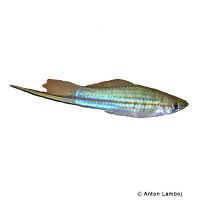Catemaco Swordtail (Xiphophorus kallmani)
| Catemaco Swordtail Xiphophorus kallmani | |
|---|---|
| Name | Catemaco Swordtail |
| Name Lat. | Xiphophorus kallmani |
| Synonym | Xiphophorus helleri "Catemaco" |
| Family | Livebearers |
| Family lat. | Poeciliidae |
| Order | Killifishes & Livebearers |
| Order lat. | Cyprinodontiformes |
| Origin | Mexico, Lake Catemaco |
| Habitat | Lake |
| Diet | Omnivore |
| pH | 7.0-8.0 |
| Behavior | Peaceful |
| Keeping | Group |
| Care Level | Easy |
| Reproduction | Livebearer |
| Breeding | Simple |
| Life Span | 3-5 years |
| Protection | No |
| Metric Units | |
| Size | 10-15 cm |
| Temperature | 22-26 °C |
| Hardness | 9-20 °dH |
| Aquarium | 160 l |
| US Units | |
| Size | 3.9"-5.9" |
| Temperature | 72-79 °F |
| Hardness | 160-356 ppm |
| Aquarium | 40 gal |
Distribution and habitat
The Catemaco Swordtail is found exclusively (endemically) in Lake Catemaco, which is located in the tropical rainforest of the state of Veracruz in southern Mexico. They live in sandy, shallow bays with dense riparian vegetation.
Maintenance
The aquarium should have a varied, partly dense planting, with shelters and hiding places (roots) and provide sufficient swimming space. Slightly shaded light (floating plants) and medium to hard water is ideal.
No ammonia, ammonium and nitrite should be detectable, the nitrate value should not exceed 100 mg/l. To ensure the water quality and oxygen content, a filter and heater adapted to the aquarium size is required, as well as lighting for the species-appropriate day-night rhythm of the animals.
Diet
The food supply consists of live food, such as cyclops, daphnia, artemia and mosquito larvae, which are also accepted without problems in frozen form, plus commercially available frozen food mixtures, supplemented with high-quality dry food (flakes, granules). In addition, they need regular vegetable food, such as algae leaves or dry food with high vegetable content (spirulina, kelp).
Only feed as much as will be eaten within a few minutes. Regular and varied feeding promotes health and prevents deficiency symptoms
Behaviour and compatibility
They are swimming, peaceful fish that should be kept in a group of at least 5, with a predominance of females. Socialization with peaceful fish, such as Rasboras, Tetras, Catfish or other live-bearing fish is very possible.
Basically, only compatible fish species with similar demands on water condition and water temperature should be socialized
Sex dimorphism
Males are smaller and have an anal fin (gonopodium) that has been transformed into a mating organ. Sexually mature males bear a "sword" on the lower part of the caudal fin. Females are larger and appear rounder.
Reproduction and breeding
Swordtails are live-bearing fish. Internal fertilization is facilitated by the male's gonopodium. Fertilized females are usually clearly recognizable by a dark colored pregnancy spot on the posterior abdomen. After 4-6 weeks of gestation, approximately 80 fry are born. They are already fully developed and independent at birth. After they have filled their swim bladder at the water surface, they can immediately start feeding.
Fry must be fed several times a day with special rearing food (Artemia nauplii). In community tanks breeding is hardly possible, because the fry are easy prey.
Important
Too soft water is not tolerated well in the long run.
The well-being of the fish should be checked regularly. The temperature should be checked daily, the pH, hardness and nitrate value at least every 14 days. Regular partial water changes are recommended, even if the contaminant level has not yet reached the upper limit. Sudden changes in water quality should be avoided. Newly introduced fish must be accustomed slowly to the water in the aquarium.
Further literature can be found in your pet store.
References
Text: petdata; Image: Anton Lamboj
Source: BMELV (1998): Tierschutzgutachten - Haltung von Zierfischen (Süßwasser); BAENSCH & RIEHL (2004): Aquarien Atlas Bd. 2, Mergus Verlag; ENGELMANN (2005): Zootierhaltung - Tiere in menschlicher Obhut: Fische, Verlag Harri Deutsch
- Gemäß § 21 Abs. 5 Tierschutzgesetz idgF
